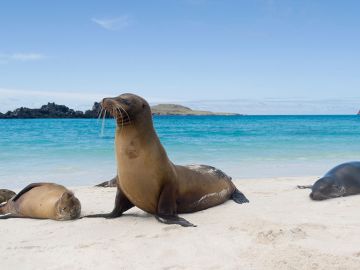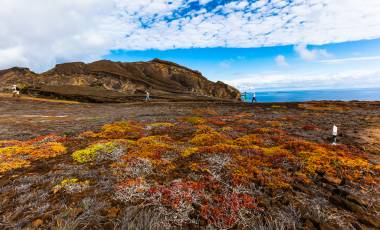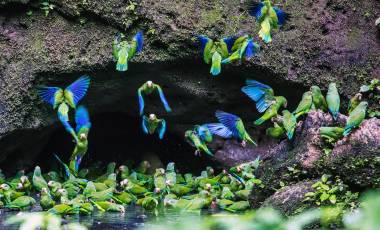The National Geographic once described the Galapagos Islands as, “A living laboratory that inspired the work of Charles Darwin” and our expert Galapagos guide, Leonidas Parrales, couldn’t agree more. “It’s important when visitors come to the Galapagos that they understand they are entering a very delicate ecosystem”. He continues, “Enjoy the beauty, see the species, see how they move, see the colours, slow down and come with the eyes of Charles Darwin… because if you come with that attitude you will love it, and you will have a unique experience that will last the rest of your life.”
To respectfully experience what this awe-inspiring ecosystem has to offer, there’s a two-metre rule for wildlife in the Galápagos National Park – though as you’ll soon see, playful sea lions rarely stick to these guidelines. Read on to find out more about some of our favourite wildlife encounters in the Galapagos and where’s best to see them, so you can start planning your own discovery in Darwin’s Enchanted Isles.

Sea lions
The Galápagos sea lion is a species that breed almost exclusively on the Galápagos Islands and in smaller numbers on the uninhabited Isla de la Plata – an island steeped in legends of Sir Francis Drake’s buried treasure, located just off the coast of Ecuador.
You could say sea lions are the ubiquitous mascots of the Galápagos, as you’ll find them just about everywhere, around every corner. Their specialities include, taking comical naps on public benches in the middle of town, lolling about on beaches, barking at each other and begging for scraps at local fish markets. In Spanish, they call them ‘lobos marinos’, which translates to “sea wolves”, but in reality, these fun-loving characters are anything but ferocious.
“The favourite for me has to be sea lions, because these guys take it easy”, Leonidas affectionately comments. He continues, “They know how to relax, they could be out on the ocean for three to four days at a time fishing and afterwards they retire to the beach. And you know what they do? They just lie. If it’s a mother coming to feed her baby and all of that, she just relaxes – that’s what life is all about here in the Galapagos.”
When it comes to the giving birth, sea lions prefer the colder currents and fresher air that comes during the dry season in the Galapagos, as the waters of the eastern Pacific Ocean are more fertile, giving mothers ample opportunities to feed off fish, squid, octopus and crustaceans so they have stronger pups. Even though they can give birth anytime during the year, your best chance to see the prime sea lion pupping season is during the months of August, September and October. Even in November, it’s not uncommon to see curious sea lion pups swimming in the waters amongst snorkelers and divers off the coast of La Lobería beach in San Cristóbal.
Our expert Galapagos guide explains, “When they are small, you can play with them and do anything with them, but the big guys they can be a bit more aggressive. I love them… they’re my favourite animal in the Galapagos for sure.”
The best way to see them:
Galápagos sea lions are the most commonly seen marine mammal in Galápagos and are bound to win you over with their playfulness and curiosity. The best place to encounter huge colonies of sea lions are on the islands of San Cristóbal, which we visit on our Galapagos Encounter Archipel I (Itinerary C) trip and on our Galapagos Encounter Archipel I (Itinerary B).

Frigatebirds
You will know when you’ve encountered the Galapagos Frigatebird in flight. Coined the “condor of the oceans”, by Charles Darwin, the Frigatebird is recognised for their graceful flight manoeuvres, exceptionally large wingspan and ability to sore high above in search for food, with some flying a remarkable 4,000 meters above sea-level.
When observing Frigatebirds in their natural habitat back in 1839, Darwin marvelled at the bird’s precision when catching its prey. “When it sees any object on the surface of the water, [it] descends from a great height… with the swiftness of an arrow; and at the instant of seizing with its long beak and outstretched neck, the floating morsel, it turns upwards, with extraordinary dexterity, by the aid of its forked tail, and its long, powerful wings.”
This species has the largest wingspan to body weight ratio of any bird in the world, and they don’t hesitate to use it to their own advantage. Well known for their mischievous pillaging behaviour, the Spanish call them, “pirate birds” because of their skilful knack for stealing food right out of other birds’ mouths – but this isn’t their only distinctive trademark. Both males of the great and the magnificent species of Frigatebirds found in the Galapagos sport a beguiling red balloon throat pouch during their mating season. While they can mate all year round, the best chances of catching the peculiar courting and nesting behaviour of these species will be during the dry season months between December and May.
Recent research into the species has also uncovered that Frigatebirds have the ability to actually sleep while in flight. Resting one hemisphere of their brain at a time, Frigatebirds can miraculously keep one eye open to stay airborne and have the capacity to fly for days on end, with some staying aloft for two months at a time.
The best way to see them:
According to our Galapagos guides, the best opportunity for viewing Frigatebirds in large colonies is on North Seymour Island. You can also find their breeding colonies on Floreana, San Cristóbal and Genovesa and can be seen spotted across the archipelago, in mangroves and deciduous trees as well as foraging over coral reefs. We get the opportunity to see these spectacular birds in flight for ourselves on the Galapagos Encounter Archipel I (Itinerary B). To have the highest chance of seeing their bright red throat pouches inflated during the mating season, we’d recommend visiting around March, as you’re sure to catch glimpses of them on the islands of Genovesa and San Cristóbal.
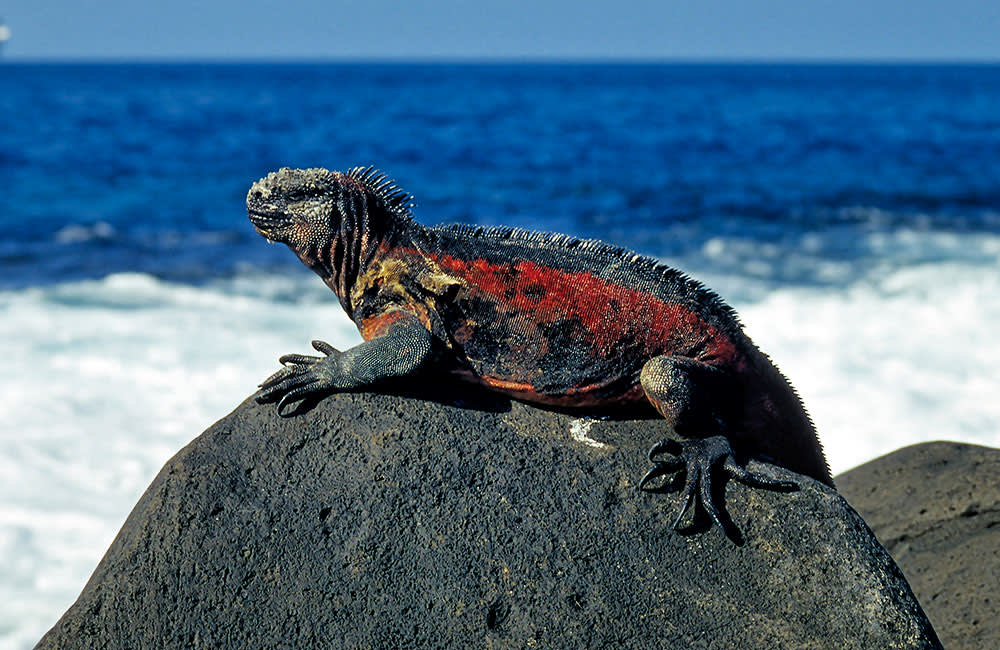
Marine iguanas
Marine iguanas are another species that are endemic to the Galapagos Islands and are also the only marine lizard you’ll find in the world. During your visit, you’re most likely to spot these creatures sunning themselves on the rocky volcanic shores across the Galapagos archipelago, allowing their spiky dorsal scales to absorb the heat in preparation for their scavenger hunts for marine algae out to sea.
Darwin may have once called marine iguana’s “hideous-looking lizards”, but when you look past their unusually wide-set eyes, black scales and salt-encrusted heads, you’ll find that these remarkable reptiles have uniquely adapted to their environment over the millennia. During their mating season from December to March, the male Marine iguanas change colour, with different subspecies across the islands displaying their own distinct colourations, from bright shades of red and green to interesting turquoise and orange hues. And you won’t spot just one, you’re likely to see heaps of them, piled on top of each other in an attempt to stay warm. If you’re lucky enough to catch them in mating season – the photo opportunities can be quite spectacular.
The best way to see them:
Large groups of marine iguanas can be found on Isabela, but Fernandina is home to one of the biggest marine iguana colonies in the archipelago. We get to see this interesting colony for ourselves on the Galapagos Encounter – Archipel I (Itinerary A) with an afternoon spent at Espinoza Point, where we’ll discover one of the world’s most untouched ecosystems.
We’d also recommend that you visit Española. The southernmost island of the Galapagos chain and the oldest, it is relatively isolated and has developed its own endemic fauna. Rumour has it, that thanks to its rich fauna and algae in the area, the colours of the Marine iguanas found on Española are said to be the most vibrant during mating season, showing bright green and red colours that have earned it the nickname of “Christmas iguana” among the locals. We get the opportunity to swim with sea lions and marine iguanas at the paradisiacal beach, Gardener Bay, on Espanola Island during our Galapagos Island – Cachalote Explorer (Itinerary A) trip.
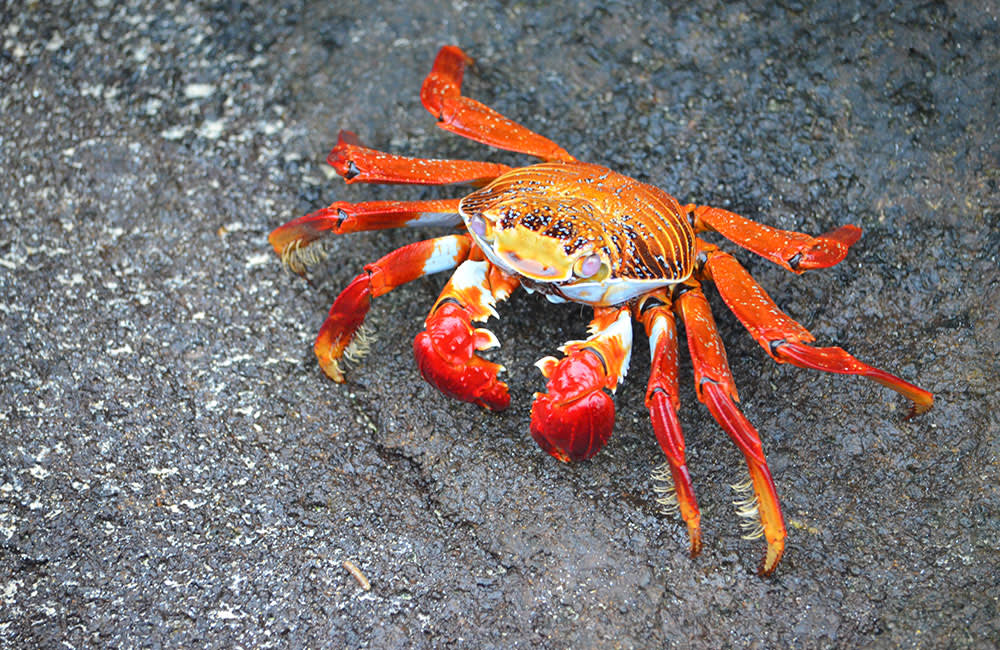
Sally Lightfoot crabs
One of the Galapagos Island’s most vibrant coastal scavengers is the Sally Lightfoot crab. A favourite among travellers to the region and locals alike, legend has it, this species of crab was named after a famous Caribbean dancer – and it’s no surprise why.
This isn’t only because of the agility they show when manoeuvring themselves on the black lava rocks, but it’s also how this twinkle-toed saltwater crab avoids its predators, as if in a fleeting dance while managing to withstand the crashing waves of the Pacific Ocean without so much as a flinch – it’s a pretty impressive sight.
Famed American author, John Steinbeck, agreed, as he wrote in The Log of the Sea of Cortez, “They seem to be able to run in any of four directions; but more than this, perhaps because of their rapid reaction time, they appear to read the mind of their hunter… anticipating from what direction it is coming. If you walk slowly, they move slowly ahead of you in droves. If you hurry, they hurry. When you plunge at them, they seem to disappear in a puff of blue smoke—at any rate, they disappear. It is impossible to creep up on them.”
The best way to see them:
You’re spoilt for choice when it comes to encountering these colourful saltwater crabs in the Galapagos Islands, pervading almost every shore you’re likely to visit, but you’ll find larger casts of crab in Española Island, Santiago Island, Fernandina Island, Floreana Island and San Cristóbal Island.
On our Galapagos Encounter Archipel I Itinerary C trip, we stop at Floreana Island to spend the afternoon at the Baroness Lookout and historic Post Office Bay where you can post your postcards in the peculiar traditional barrel and spot Sally Lightfoot crabs crawling along the rocks. You can also find them on the next stop in Gardner Bay on Espanola Island – a true crown jewel of the Galapagos.
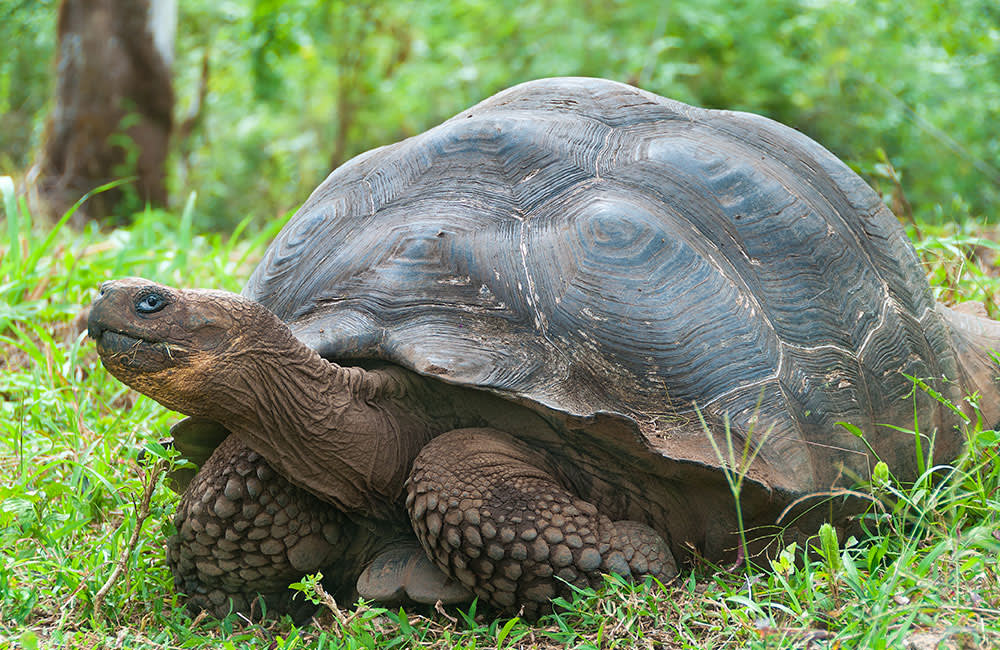
Giant tortoises
Often affectionately termed as “the gentle giants of the Galapagos”, Giant tortoises have long since intrigued travellers to the archipelago. Spanish sailors who initially discovered the region back in 1535, presumably named the archipelago “galápago”, the Spanish word for “tortoise” after encountering an abundance of Giant tortoises on their journey.
Sadly, hunted by merchantmen, explorers, pirates and whalers for ship sustenance over the past couple of centuries, the Giant tortoise species has diminished. But thanks to the captive breeding efforts conducted by the Charles Darwin Research Station, they are now making a comeback and roam freely across several islands in the archipelago. They are most likely to be encountered on a trip to the lush highlands of Isla Santa Cruz.
The Galápagos tortoise are the largest living species of tortoise in the world, with some specimens exceeding 5 feet in length and weighing up to an astonishing 550 pounds. The Ecuadorian Government put these spectacular creatures on the protected species list back in 1936, and you could say they’ve remained a treasured mascot of the Galapagos ever since.
Legend also has it, that amidst the giant tortoises wandering around the Galápagos Islands today, there exists an old-timer that could well have been a hatchling at the time of Charles Darwin’s famous exploration in 1835, which gives another layer of remarkable history to uncover when you’re exploring these enchanting isles.
The best way to see them:
Our Galapagos guides recommend heading to the Santa Cruz highlands and the Alcedo Volcano on Isabela to see the largest populations of giant tortoises. On our Galapagos Encounter – Archipel I (Itinerary D), we enjoy seeing wild Galapagos giant tortoises roaming through pastures in the agricultural zone and in the transition zone of adjacent El Chato Tortoise Reserve on Santa Cruz, ending our journey by learning more about the extraordinary life of Lonesome George in the Charles Darwin Research Station.
After running through our top wildlife encounters you can have in the Galapagos, we’ll leave you with this poignant message from our Exodus expert guide, Leonidas, “I am lucky to be living here and to have the chance to be continually discovering this magnificent archipelago. It is necessary to protect them always and forever, because there’s no other place on the planet like the Galapagos, it’s truly unique – it’s special.”
To discover the magic of the Galapagos for yourself, take a look at our Exodus trips here.
